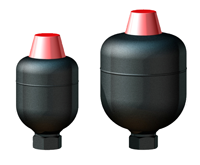
Pulsation damperners: what are they and what are they used for?
Working principle and essential applications of accumulators in fluid systems
In hydraulic and fluid systems, pressure management is an aspect that should not be underestimated in order to ensure efficiency, safety, and longevity of components. Often, the pressure inside a circuit is not constant, but can vary due to load peaks, sudden interruptions, or pulsations generated by pumps. To mitigate these effects and optimize system operation, so-called pulsation damperners are used.
But what exactly are they and, above all, what is the purpose of a pulsation damperner in a circuit?
Pulsation damperners: how they work
The operating principle of pulsation damperners is based on the separation of a volume of compressed gas (usually nitrogen) from a volume of hydraulic fluid by means of a movable element, which can be a diaphragm, a bladder, or a piston, depending on the specific type of damperner.
Before being put into service, the accumulator is precharged with nitrogen (or another inert gas) at a predetermined pressure; when the hydraulic system is in operation and the fluid pressure exceeds the gas precharge pressure, the fluid begins to enter the accumulator, further compressing the gas. The energy of the fluid is thus stored as potential energy in the compressed gas. Conversely, when the pressure in the system falls below the pre-charge pressure (or the pressure reached during the storage phase), the gas expands, pushing the stored fluid out of the device and back into the circuit.
There are different types of accumulators, each with slightly different characteristics, but all based on this general principle:
- Bladder accumulators: an internal elastic bladder, pre-charged with gas, is contained within a metal shell. The fluid enters the shell around the bag and compresses it. They offer excellent dynamic response and are suitable for damping pulsations;
- Diaphragm accumulators: similar to bag accumulators, but use a flexible diaphragm to separate gas and fluid. They are more compact and generally used for smaller volumes or applications with limited space;
- Piston accumulators: a movable piston separates the gas from the fluid. They are suitable for large volumes, high pressures, and can operate in any position. They offer excellent efficiency and durability, but are less suitable for dampening high-frequency pulsations than bag accumulators.
What are pulsation damperners used for: applications and advantages
Understanding what a pulsation damperner is used for is important for improving the efficiency, safety, and stability of hydraulic systems. Its ability to store and release energy makes it indispensable in a wide range of applications.
Here are the main purposes and advantages of using a pulsation damperner:
- Pulse damping: Piston pumps, by their nature, generate a pulsating flow, which can cause vibration, noise, component wear, and process instability. The accumulator acts as a shock absorber, absorbing pressure pulses and transforming the pulsating flow into a more constant and uniform flow, extending the life of valves, pipes, and other fatigue-sensitive elements.
- Compensation for volume and temperature variations: hydraulic fluids expand and contract with temperature changes. An accumulator can compensate for these volume variations, maintaining stable pressure in the system and preventing excessive pressure rises or drops that could damage the circuit or compromise its operation.
- Pressure maintenance: in some systems, it may be necessary to maintain a certain pressure even when the pump is off or inactive. The accumulator can store a reserve of pressurized fluid that can be released slowly to compensate for small internal leaks or to maintain a minimum required pressure level;
- Emergency power supply: in the event of pump failure or power failure, the accumulator can provide sufficient hydraulic power reserve to complete an operating cycle or activate a safety function, proving vital for operator safety and equipment protection;
- Absorption of hydraulic shocks: rapid opening and closing of valves or sudden changes in load can generate very high pressure peaks, known as “water hammer.” The accumulator absorbs these shocks, protecting pipes and components.
Thanks to these advantages, accumulators are used in a wide variety of sectors, from machine tools to lifting equipment, from braking systems to agricultural machinery and, of course, in high-pressure washing and cleaning systems.
Maintenance of pulsation damperners
Accumulators are generally robust, but require periodic checks to ensure optimal operation. Checking the precharge pressure is the most important operation and should be performed regularly, as gas leaks can drastically reduce its effectiveness. At the same time, it is also advisable to check the integrity of the outer shell and fittings for any fluid leaks.
Hawk pulsation damperners: reliability and performance
Hawk Pumps, a leading manufacturer of high-pressure piston pumps, supplies pulsation damperners designed to improve the efficiency and durability of various installations.
Hawk pulsation damperners integrate seamlessly with the pumps and systems in our catalog, offering reliable solutions for pulsation management. These devices help extend the service life of the entire system by reducing stress on pipes, fittings, and valves and ensuring a more uniform flow to the nozzle.
Choosing Hawk pulsation damperners means benefiting from high-quality components, built to withstand the harsh operating conditions typical of high-pressure systems.
For more information, please contact us: our team of experts is at your complete disposal to provide you with personalized advice.
Share this Article